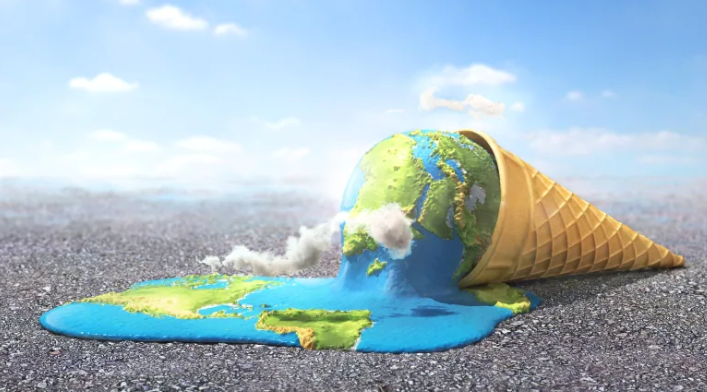Overview
Climate change refers to significant, long-term shifts in Earth’s weather patterns or average temperatures. Historically, climate systems have varied naturally, with changes occurring in cycles over tens of thousands of years, resulting in Ice Ages and interglacial warming periods. These cycles are influenced by the shape of Earth’s orbit and the tilt and direction of its axis. Additionally, solar variability and volcanic activity have also played roles in historical climate trends.
However, scientific research indicates that natural causes do not explain the recent changes in climate. Notably, ten of the hottest years on record have occurred within the last 18 years. Extreme weather events such as storm surges, floods, heavy precipitation, tropical storms, heatwaves, wildfires, and droughts have increased fourfold over the past 35 years, rising from 38 events in 1980 to 174 events in 2014. Consequently, the cost of these disasters has increased tenfold. (CLIMATE CHANGE 101, n.d.)
Since the early days of geology, scientists have recognized that Earth’s climate is constantly changing. As early as the 1800s, scientists proposed that humans could potentially alter the Earth’s climate due to the “greenhouse” properties of certain atmospheric gases.
In the late 1960s, scientists discovered that carbon dioxide levels were increasing by approximately 0.5% per year. By the late 1970s, early computer models were able to estimate the impact of continued carbon dioxide rise on temperature extremes, changing precipitation patterns, and sea level rise.
By the 1990s, compiled climate data confirmed that the temperature increases observed in the 20th century were beyond what could be expected from natural variations alone. Over the past decade, a substantial body of evidence has confirmed the current changes in Earth’s climate and their implications for our future. (Climate Change 101, n.d.)
The effects of climate change
Over the next century, global climate change is projected to affect billions of people through several significant impacts:
Increased flooding due to rising sea levels.
Greater exposure to extreme heat waves.
Deteriorating air quality, negatively affecting heart and lung health.
Higher prevalence of disease-spreading insects, such as ticks and mosquitoes.
More severe droughts and storms.
Reduced food production.
While local impacts are more challenging to predict, potential negative consequences could include adverse effects on agriculture, winter recreation, forestry, and fishing industries, among others.
Although climate change can occur naturally, the current rate of human-induced climate change is exceptionally rapid. This accelerated pace is likely to affect humans and other organisms in ways that are difficult to adapt to.
How to Combat Climate Change
Speak Up!
Talk to friends and family about climate issues and encourage your representatives to support policies that limit carbon emissions.Use Renewable Energy.
Choose a utility that generates at least half its power from wind or solar. Check your electric bill for options.Weatherize Your Home.
Make your home more energy-efficient by sealing drafts and insulating properly. Consider a home energy audit.Invest in Energy-Efficient Appliances.
Look for the Energy Star label when buying appliances. They save energy and reduce emissions.Reduce Water Waste.
Use less water to save energy. Shorten showers and install water-efficient fixtures.Minimize Food Waste.
Eat the food you buy and compost scraps instead of throwing them away to reduce methane emissions.Choose LED Bulbs.
Switch to LED light bulbs, which use significantly less energy and last longer than traditional bulbs.Unplug Devices.
Many devices consume energy even when not in use. Unplug them or use power strips to save energy.Drive Efficient Vehicles.
Opt for fuel-efficient or electric cars to save money and reduce emissions.Maintain Your Vehicle.
Keep your tires inflated and perform regular tune-ups to improve fuel efficiency.Consider Transportation Options.
Live in walkable areas and use public transport. Choose trains over planes when possible, and consider carbon offsets for flights.Reduce, Reuse, Recycle.
Minimize waste by reducing what you buy, reusing items, and recycling according to local guidelines.
By making these changes, we can significantly impact climate change together! (How to Stop Global Warming, Solutions to Prevent Climate Change, 2022)
References
CLIMATE CHANGE 101. (n.d.). Climate Bonds Initiative. Retrieved July 12, 2024, from https://www.climatebonds.net/climate-change-101
Climate Change 101. (n.d.). A clearinghouse on aging and climate change. Retrieved July 12, 2024, from https://climateaging.bctr.cornell.edu/learn/climate-change-101
How to Stop Global Warming, Solutions to Prevent Climate Change. (2022, April 20). NRDC. Retrieved July 12, 2024, from https://www.nrdc.org/stories/how-you-can-stop-global-warming
